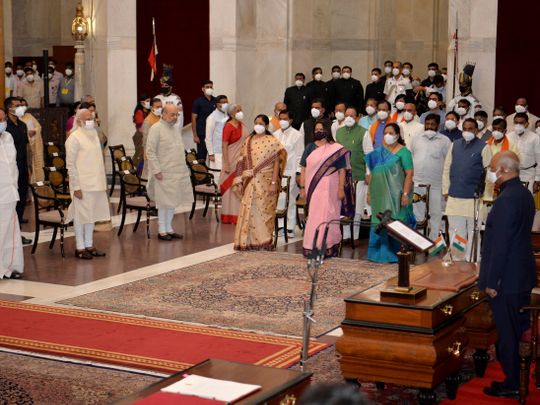
This even Indian Prime Minister Narendra Modi’s worst detractors will grudgingly admit, in private, if not in public. The major restructuring of his Council of Ministers on July 7 was a masterstroke.
What was hyped and publicised as a “reshuffle” actually turned out to be a massive upheaval, much more than what anyone had expected. It was nothing short of a makeover.
More appropriately, we ought to denominate it as a significant reorganisation of ministers, ministries, and portfolios. But that would be polite, corporate-style lingo. In the eyes of the people, it was not merely the customary midterm rearrangement or readjustment — old wine in new bottles, so to speak. It was nothing less than an rejig, shake-up, makeover.
Modi, his finger ever on the political pulse of the masses, delivered his masterstroke when the Bharatiya Janata Party (BJP) as well as his own government, had taken a severe battering in the deadly second wave of the COVID-19 pandemic. When the whole nation was recovering from the ghastly grasp of the tiny virus that had wreaked death and destruction, some major move on the part of the government was expected.
Working together for a better tomorrow
Not merely holding fort or pushing the tired old slogans would do. New energy, commitment, and action were needed to uplift the spirits of the people and bestir the masses to work together for a better tomorrow after a sad yesterday. The Cabinet expansion and reorganisation did precisely that.
In typical Modi style, the Prime Minister false-footed all the pundits and experts. While the build-up to the reshuffle had been long, going back several months, team Modi deftly put it off till just about ten days before the monsoon session of the Indian Parliament, expected to start on July 19.
In fact, till a couple of days before the actual makeover, no one had a clue what was going on. As rumours, speculations, and misinformation were rife, a plethora of misleading names began to make the rounds, also building up the suspense. Modi knew that his plans could not be kept under wraps till the end simply because the prospective inductees would have to arrive in the capital, New Delhi.
There would be hectic parlays and meetings, with the usual movement of VIP vehicles, their security details, not to mention the cavalcade of supporters, hopefuls, and also-rans. None of this could happen off-camera or away from the gawking gaze of reporters.
Members of India’s hyperactive press, both national and regional, like the proverbial hounds, would be sniffing for scoops and leaks. Each major news organisation with its own sources, would claim access to the most guarded byzantine corridors of power.
Anticipation, rumours and political buzz
Just a day before, on July 6, the names of the new entrants began to be flashed on both mainstream and social media. Then, within just twenty-four hours, the show was on, with the actual swearing in at Rashtrapati Bhavan, in a grand and solemn ceremony.
No less than 15 Cabinet ministers and 28 Ministers of State were inducted. What is more, some dozen sitting ministers had to go, which included six top, cabinet members. There was also a gubernatorial juggle the previous day in which only one of these was accommodated.
Modi broad-based his ministry by including more members from the National Democratic Alliance (NDA). This ruling coalition, with BJP at its helm, has as many as 27 member parties. These smaller parties could not be ignored because they have 46 members in the Parliament, 29 in the Lok Sabha and 17 in the Rajya Sabha.
As to the caste calculus, Modi’s cabinet has now taken a distinct OBC (Other Backward Class) look while the BJP has traditionally been criticised as a “Brahmin-Bania” party. Several Scheduled Caste and Tribe leaders belonging to a variety of numerically significant communities have also been added, as have women and minorities — Muslim, Christian, Sikh, Buddhist.
Political dexterity and finesse
In a previous column, I had myself suggested that four “Ps” — politics, pragmatics, performance, and perception would determine the future of the Modi government. In this reshuffle, Modi has aced all four. The reshuffle was staged, as we have already seen, with masterly dexterity and finesse.
It was secret, unpredictable, and totally high-impact. The new ministers have already taken charge and have started performing. On the pragmatic front, Modi has scored high on the math of caste, gender, region, state, community, and allied party calculations. What remains now is politics, which when it comes to India, is perhaps the most complicated in the world. Once again, it is clear that team Modi has come out on top.
After losing the Bengal assembly elections in April 2021, all eyes are now on India’s largest state, Uttar Pradesh (UP), where the state polls are scheduled for February/March 2022. Along with UP, Goa, Manipur, Punjab, and Uttarakhand will also go to the hustings around the same time. Later in the year, Himachal Pradesh, Gujarat, will follow.
Of these seven states, the BJP, on its own, rules in five — UP, Goa, Uttarakhand, Himachal Pradesh, and Gujarat. In Manipur, it leads a coalition of three parties, the other two being the National People’s Party and the Naga People’s Front. The only exception is Congress-ruled Punjab, where Capt. Amarinder Singh is the Chief Minister.
Keeping this in mind, Modi acted in a manner that would make instant sense to the masses. His smart Cabinet expansion was less a reshuffle than a major redistribution of power. At the same time, the message to his Cabinet colleagues, old and new, was simple — shape up or ship out.
Some have called the Modi’s Cabinet rejig a gamble. On the contrary, it indicates a well-thought out and astute strategy. It shows Modi, once again, miles ahead of his competitors and critics. What remains to be seen, however, is whether Modi’s master plan will continue to prevail despite the odds and difficult circumstances.









